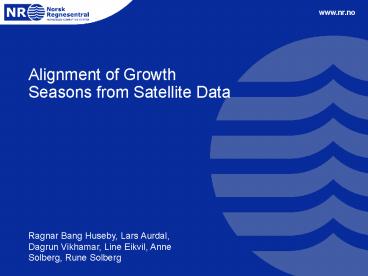Alignment of Growth Seasons from Satellite Data - PowerPoint PPT Presentation
1 / 18
Title:
Alignment of Growth Seasons from Satellite Data
Description:
Determine the correspondence between the chronological time of the image ... Problems with naive approach... May 23rd 2004. June 5th 1997. www.nr.no. How? ... – PowerPoint PPT presentation
Number of Views:36
Avg rating:3.0/5.0
Title: Alignment of Growth Seasons from Satellite Data
1
Alignment of Growth Seasons from Satellite Data
Ragnar Bang Huseby, Lars Aurdal, Dagrun Vikhamar,
Line Eikvil, Anne Solberg, Rune Solberg
2
What?
- Determine the correspondence between the
chronological time of the image acquisition and
the time at which the phenological state of the
vegetation cover shown in the image would
typically occur.
?
?
Landsat image
3
Why?
- The work is motivated by a high mountain
vegetation classification problem in Norway. - Vegetation classes are characterized by their
temporal evolution through a growth season. - Data of high spatial resolution are often
temporally sparse. - In order to get a longer sequence of images,
data from different years should be combined into
one single synthetic sequence.
4
Combining image data
May 19th May 23rd June 5th June 25th July
24th July 29th August 17th August 19th October
18th
Naive approach
5
Problems with naive approach...
May 23rd 2004
June 5th 1997
6
How?
NDVI The normalized difference vegetation index
Extract the maximum NDVI from the region of
interest.
7
NDVI in various growth seasons
alignment of growth seasons alignment of NDVI
curves
8
Model of observations
is the expected NDVI as a function of
phenological time.
9
Double logistic function
The parameters can be estimated from data from a
given year.
10
Time warping functions
Early spring
Normal spring
Late spring
11
Minimization problem
We wish to determine the warping function .
The discrepancy between model and observations
should be small.
Minimizing this object function produces weird
results.
12
Object function
We wish to determine the warping function .
The warping function minimizes the sum
13
Dynamic programming
- Discretize time
- Finite but huge number of feasible solutions
- Find optimal solution by dynamic programming
- Similar approaches have been used in speech
recognition.
14
Experiments
- Dataset for time warping
- Global Inventory Modeling and Mapping Studies
(GIMMS) - A sequence of NDVI composites extracted from
- NOAA AVHRR data from the period 1982 2003.
- 24 images from each year.
- In addition, MODIS data from 2003 and 2004.
- Test site Region in Norway including mountain
areas.
15
Results
16
Images in correct order!
Day 156, 1997
Day 144, 2004
17
Application
- The results from this study have been used in
the work titled - Classification of Multitemporal Satellite Images
Using Phenological Models - also a talk at MultiTemp 2005.
18
Conclusions
- We have proposed a methodology for alignment of
growth seasons from satellite data. - The proposed methodology has been tested on data
from several years covering a region in Norway
including mountain areas. - The results show that it is possible to combine
data from several years into a sequence of
observations from one season. - We expect that the methodology will serve as a
useful tool in multi-temporal classification.































